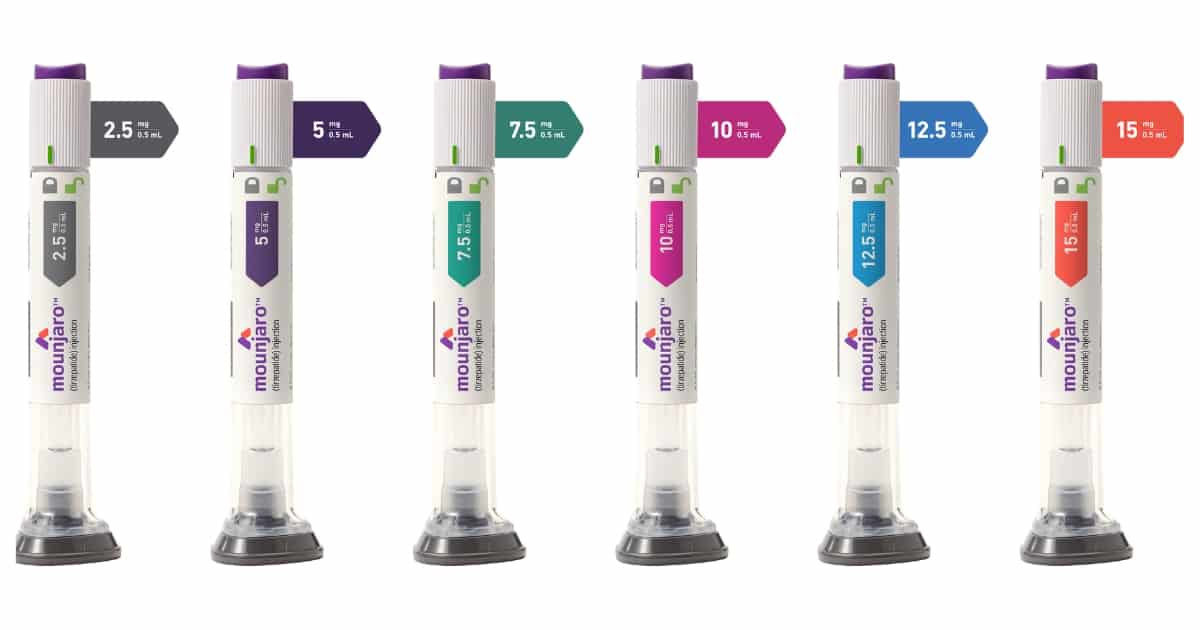There are different Mounjaro doses available. Yours will depend on your health history, health goals, lifestyle, and weight.
Figuring out how much Mounjaro to take can take time, and it should always be a decision made jointly with your doctor.

Key facts
- The typical starting dose of Mounjaro is 2.5 milligrams (mg) once per week, chosen to minimize potential side effects like nausea and vomiting. The body usually adapts to the medication within a few weeks.
- There is no standard “normal” dose for Mounjaro, as it varies based on individual factors such as health history, weight, and treatment response.
- Doses can be increased from 5 mg weekly after the first month up to a maximum of 15 mg, depending on your doctor’s evaluation.
- Dosage adjustments are made carefully to monitor blood sugar management and side effects, typically not before four weeks of treatment.
- Mounjaro has shown effectiveness in weight reduction and has been approved in a weight-loss version known as Zepbound. The dosage for weight loss should be guided by a doctor.
Table of Contents
- What dose do you typically start with?
- What is a normal Mounjaro dose?
- How and when can you increase your dose?
- What is the right dose for me?
- What is the right dose for weight loss?
- Are there different Mounjaro pens?
- What happens if I stop taking Mounjaro?
- What is the strongest Mounjaro?
- What do I do if I forget to take my dose?
- Can you overdose on Mounjaro?
- How do I store Mounjaro?
What dose do you typically start with?
If you’re new to Mounjaro (tirzepatide), your doctor will want to start you on a low dose.
This is because Mounjaro may cause adverse side effects, including nausea, vomiting, diarrhea, constipation, low blood sugar, and decreased appetite.
These symptoms usually go away after a few weeks of starting the drug, but taking a lower dose when you begin treatment can help prevent them altogether.
According to the manufacturer, a typical starting dose is 2.5 mg, taken once per week. This amount doesn’t affect blood sugar levels, but it does help your body get used to the medicine. The drug is taken as an injection just under the skin.
If you’re seeing improvements in blood sugar levels and insulin resistance without adverse side effects, your doctor may increase your dose after the first four weeks.
What is a normal Mounjaro dose?
There is no “normal” dose of Mounjaro because everyone is different.
But there are specific increments that people take Mounjaro in. They are as follows:
- New to treatment: 2.5 mg once per week for the first four weeks
- Ongoing treatment: 5+ mg once per week starting on week five
If your blood sugar levels are still not under control with 5 mg once weekly, your doctor may increase your dose.
How and when can you increase your dose?
You most likely will not be able to increase your initial dose until after you’ve been on the medication for at least four weeks.
At week five, your doctor may advise you to double your dose to 5 mg for four additional weeks.
You should closely monitor your blood sugar levels and note any adverse side effects when increasing your dose, as this is when you’re most likely to experience symptoms such as nausea, vomiting, and diarrhea.
If you’re tolerating 5 mg well and not seeing improvements in blood sugar management, your doctor may advise an additional increase.
If you require a larger dose, your doctor may increase your medication to either 7.5 mg, 10 mg, 12.5 mg, or 15 mg, taken once a week as your maintenance dose.
Note that each increase will require a new prescription because each larger dose comes in a bigger dosing pen.
Doses should not be increased by more than 2.5 mg every four weeks.
What is the right dose for me?
You and your doctor will determine your dose.
It may vary based on your health history, health goals, lifestyle, height, weight, level of insulin resistance, diet, and daily activity level.
Higher doses will yield more results, such as lower blood sugar levels, weight loss, and improved A1c levels (a measure of glucose control over the previous 2 to 3 months).
However, the higher the dose, the more likely you are to experience adverse side effects.
Keep this in mind as you scale up your doses, and only ever do so under the guidance of your doctor.
Never take more Mounjaro than you’ve been prescribed.
What is the right dose for weight loss?
Mounjaro is not approved by the U.S. Food and Drug Administration (FDA) as a weight-loss medicine.
However, based on clinical research supporting this outcome, the FDA has approved a sister drug called Zepbound for weight loss. (Zepbound is the same medicine as Mounjaro but with a different name for use as a weight-loss treatment.)
Zepbound is approved for use in overweight or obese adults with at least one weight-related condition.
The FDA’s approval of the medicine was based primarily on the results from two trials.
Read more in: Can Mounjaro Help You Lose Weight?
Are there different Mounjaro pens?
Mounjaro is available in six different dosing pens. They come in the following variations:
- 2.5-mg pen
- 5-mg pen
- 7.5-mg pen
- 10-mg pen
- 12.5-mg pen
- 15-mg pen
Each pen is prefilled with a single dose. The pens come in different colors depending on the dose they contain.
For a 30-day prescription, you will receive four pens in your prescribed dose.
This makes overdosing on the medication less likely.
If and when you’ve been prescribed a larger dose, you will need a new prescription each time your dose goes up.
What happens if I stop taking Mounjaro?
Do not stop taking any diabetes medications without the guidance of your doctor.
After stopping Mounjaro, many people will regain lost weight and may experience higher blood sugar levels from increased insulin resistance and hunger.
If you wish to stop taking Mounjaro, your doctor will likely taper your dose to lessen the side effects as the medication leaves your system.
Talk with your doctor if you are experiencing severe negative side effects, Mounjaro doesn’t fit into your lifestyle, or your health insurance doesn’t cover the medication.
What is the strongest Mounjaro?
All of the Mounjaro pens contain the same active ingredient — tirzepatide. The larger dosing pens do not have a more potent drug formulation.
When people increase their dose of Mounjaro, they simply increase the amount they take per week.
What do I do if I forget to take my dose?
Remember to take your Mounjaro on the same day each week, at generally the same time (for example, over breakfast). There is no best time of day to administer the medicine — you can do so at whatever time works best for you.
The medicine is given as a shot into the fatty part of the skin on the top of the thigh, belly area, or upper arm. Make sure to rotate the injection site each time to help prevent skin irritation and improve absorption.
If you miss a dose of Mounjaro, take it as soon as possible within four days of your missed dose.
If you miss a dose for more than four days, skip that week and resume taking your Mounjaro on your regular schedule the following week.
Do not take two Mounjaro doses within three days of each other.
Missing one dose will not significantly affect your blood sugar levels or insulin resistance, and it won’t make you gain weight.
Can you overdose on Mounjaro?
Yes. If you overdose on Mounjaro, you may experience severe side effects, including nausea, vomiting, and low blood sugar, which can be fatal (especially if you’re also on insulin).
Monitor for signs and symptoms of extremely low blood sugar that include:
- Dizziness
- Confusion
- Increased heart rate
- Shallow breathing
- Shakiness
- Grogginess
- Fatigue
- Unconsciousness
Seek emergency medical attention immediately if you suspect you’ve overdosed on Mounjaro.
How do I store Mounjaro?
Store your medicine at a temperature between 36 to 46 degrees Fahrenheit (2 to 8 degrees Celsius).
Ensure that it gets no hotter than 86 degrees Fahrenheit (30 degrees Celsius).
Never freeze your Mounjaro pens.
The medication can be left unrefrigerated for up to 21 days if the temperature never exceeds 86 degrees Fahrenheit (30 degrees Celsius).
Keep your pen in its original casing to protect it from sunlight.






Michael Bell
I don’t have insurance right now and I can’t get my medicine Mojarro 5 mg EpiPen I haven’t had it in three weeks. I can’t afford. What do I do? I take metformin, but I don’t know what to do.
Christel Oerum, MS
You have to reach out to your doctor and discuss alternatives